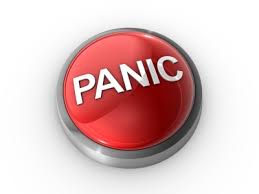Lesson 1: Clinical Disorders - Part A
PART A
Panic Disorder
Individuals experiencing this disorder suffer from unexpected attacks of anxiety that develop abruptly and reach a critical point within a short period of time (often between two and ten minutes.) These periods of intense fear and discomfort involve at least four of the following symptoms which peak within 10 minutes.:
|
Symptoms • heart palpitations or a “pounding” heart |
 People with Panic Disorder experience recurrent, unexpected panic attacks and they greatly fear having another attack. This concern and worry is part of the diagnosis of panic disorder. Some individuals may become afraid to leave the house (agoraphobia) to avoid triggering another attack. Some may fear they are "losing their mind" or feel they are going to die. For a panic disorder diagnosis, a person must experience at least four attacks in one month or fewer attacks accompanied by extreme fear of recurrence.
People with Panic Disorder experience recurrent, unexpected panic attacks and they greatly fear having another attack. This concern and worry is part of the diagnosis of panic disorder. Some individuals may become afraid to leave the house (agoraphobia) to avoid triggering another attack. Some may fear they are "losing their mind" or feel they are going to die. For a panic disorder diagnosis, a person must experience at least four attacks in one month or fewer attacks accompanied by extreme fear of recurrence.
Many individuals experience panic attacks during periods of high stress. Most, however, resume normal  functioning without further incident. Only a very small portion of the population develop panic disorder. Some statistics say 2-3% of the general population are affected - slightly more females than males. The onset of panic disorder is commonly between the ages of 15-25. People who have parents with panic disorder have an eight times higher risk of also developing panic disorder themselves. To summarize, people with panic disorder have the following symptoms: a sense of impending doom and worry, difficulty breathing (in addition to many other physical symptoms), and a desire to escape or avoid people, places, and events that produce anxiety. Like all anxiety disorders, panic disorder can grow progressively worse if not treated. Please read Case Study Four that combines a review of panic disorder with a unique biological causal factor!
functioning without further incident. Only a very small portion of the population develop panic disorder. Some statistics say 2-3% of the general population are affected - slightly more females than males. The onset of panic disorder is commonly between the ages of 15-25. People who have parents with panic disorder have an eight times higher risk of also developing panic disorder themselves. To summarize, people with panic disorder have the following symptoms: a sense of impending doom and worry, difficulty breathing (in addition to many other physical symptoms), and a desire to escape or avoid people, places, and events that produce anxiety. Like all anxiety disorders, panic disorder can grow progressively worse if not treated. Please read Case Study Four that combines a review of panic disorder with a unique biological causal factor!
For a diagnosis of panic disorder, a patient must have:
1. Recurrent unexpected panic attacks
2. One or more of the attacks have been followed by > 1 month of:
- Worry about the implications of the attack or its consequences
- A significant change in behaviour as a result of the attacks
- Persistent concern of having additional attacks
3. Can be +/- agoraphobia
4. Panic attacks are not due to substance abuse, medications or a general medical condition.
5. Panic attacks are not better accounted for by another mental disorder.
To learn more about panic disorder, click on the link below:
|
Teen Mental Health http://teenmentalhealth.org/learn/mental-disorders/panic-disorder/ |